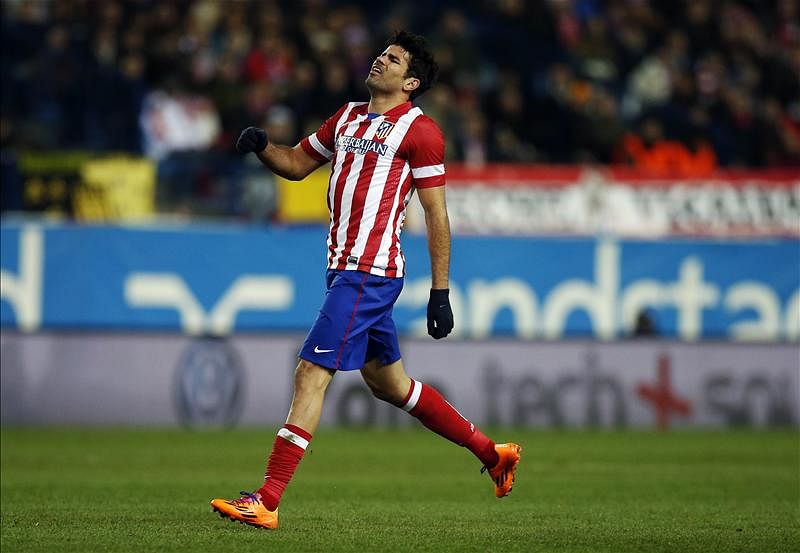With speculation hailing the arrival of Diego Costa from Atletico Madrid with a price tag of £50m and a contract worth £185,000-a-week as Chelsea Football club’s next big striker acquisition, many are calling an end to the curse that has haunted the club since the arrival of Fernando Torres from Liverpool Football Club.

At a glance, Diego Costa has been making waves this season in Diego Simeone side. Atletico are on the cusps of wining the La Liga, and Diego Costa’s goals have been the driving factor behind their success. But is Diego Costa really the man capable of successfully leading Chelsea’s front line? To answer this, we have to look back to the transfer window of January 2011, where another striker entered the club as the next big thing.
Fernando Torres joined Chelsea in a £50m move from Liverpool. Back then, he was billed as the replacement for Club legend Didier Drogba, a man who was at the twilight of his career. This situation, though not completely similar, mimics that of Diego Costa.
For Torres then, not only was a £50m transfer fee weighing on his head, the striker was charged by the fans with the task of revitalizing a team that was then languishing in the premier league table. The result, as many would know, was nothing short of dreadful. Since his arrival till now, Torres has struggled to recreate his fabled performances for Liverpool. And now, he faces the axe in the summer.
In retrospect, a variety of reasons for Torres’s disappointing performances had been heavily covered. Torres was a completely different striker, brought in to play for a team too accustomed to Drogba’s play style. Between the two, Drogba was a striker who held up play and used his strength and power to create chances for himself. Torres was a striker who clung onto the shoulder of the last defender, using his pace to latch onto through balls and score.
In a team then devoid of creative players capable of playing to Torres’s strengths, Torres was forced to adapt to a completely new play style. Torres began learning to play with his back to goal. His partnership with Drogba, was a pairing that had zero chemistry.
With an underwhelming first season, the club chose to refocus their efforts into building a team around Torres. A creative player by the name of Juan Mata was brought in to help Torres flourish, but injuries, poor form and the renaissance of Drogba kept Torres away from the first team. His contributions of 11 goals in 49 appearances, despite winning the champions league marked another poor season.
In 2012/2013, the departure of Drogba and the arrival of creative starlets like Hazard and Oscar meant that the club had finally committed to Torres. However, as the season went on, despite the purchase of highly gifted playmakers, Torres failed to flourish.
Looking back, this author realizes that the environment at Chelsea had never suited the Spaniard despite the club’s transition towards playing more attractive football. With Hazard, Mata and Oscar behind him, Torres was forced to play on their wavelength instead.
For a striker used to hanging on the shoulder of the last defender, the triumvirate of Hazard, Oscar and Mata (and now Willian) slowed things down. Instead of long searching through balls to the striker, Chelsea’s creative midfielders like Hazard were given more freedom to dribble forward and create. Torres once again, had to adapt his play style to become more of a fox in the box, rather than a striker playing off the last defender. This is also probably why, Samuel Eto, a striker who came in more comfortable with playing on the flanks and in tight spaces around the box, fared better than Torres or Demba Ba.
Now as this season draws to a close, the eminent arrival of Diego Costa throws a new striker into Chelsea’s solid backbone of defence and midfield. However, is Diego Costa the right striker to finish of chances created by the creative hub supporting him?
Statistics tell us that Diego Costa is one of the most lethal strikers in the world. 27 goals in 32 appearances dwarf Chelsea’s combined frontline output but do not tell us his preferred play style. Examining Chelsea’s match against Atletico Madrid in the Champions league semi-finals however, can provide a better look.
During the match, Diego Costa lined up in a 4-4-2 and played off Raul Garcia. A majority of touches he made were with his back towards the goal, and Costa also showed good heading and ball control skills to bring down long balls provided from midfield. In summary, his performances would remind many of Didier Drogba, strong powerful and excellent hold up play. But is a Drogba like striker what Chelsea need at the moment?
In 32 appearances this season, Diego Costa has created a total of 40 chances, 3 of which led to assists. This is much lower than other “Well performing” strikers in Europe. For example, Zlatan Ibrahimovic has created 66 chances (11 assists) while Suarez has created 80 chances (12 assists). Both have similar goal outputs with 25 goals and 30 goals respectively.
Though many might argue that chances created do not matter when it comes to strikers, this author begs to differ. In a highly unique midfield like Chelsea’s, it is important to not only bury the chances given, but also create chances for others. A target man like Diego Costa provides a good reference point for the team, but an ability to bring out the best in the other players is also highly valued. Diego Costa, though a virtuoso in the art of scoring goals like Drogba, seems to fit like a square peg in a round hole.
There is without a doubt that Costa is the ideal striker for Mourinho, after all, Drogba excelled under the Portuguese and Costa stands to do the same. But the circumstances now differ greatly, a team was built around Drogba, Costa now goes into a team already built. That team needs a different breed of striker than Costa.
Only time will tell whether Diego Costa can flourish in this new Chelsea squad. Diego Costa does possess better technical skills than Drogba, perhaps those factors would help him assimilate better into the Chelsea midfield. However, time needed for such a transition, could provide obstacles for Chelsea’s title challenges next season. Should another Torres like case occur, the consequences will be dire.
Admittedly, this writer believes that strikers in the mould of Luis Suarez (or the man himself) represent the ideal purchase for Chelsea to top off a solid title challenging team. But with the confirmed purchase of Diego Costa lurking, fans should consider before pinning all of their hopes on the Atletico Madrid striker being the solution to Chelsea’s striking woes.
*Stats taken from squawka.com
